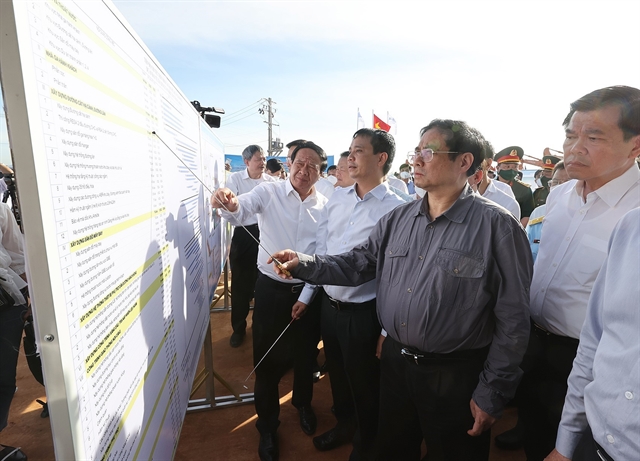 Society
Society


|
| Prime Minister Phạm Minh Chính ̣(second from right) and the working group of the Government in an onsite inspection to Long Thành airport project on Sunday. VNA/VNS Photo |
HÀ NỘI — Prime Minister Phạm Minh Chính has urged authorities to speed up the progress of the Long Thành International Airport project in southern province of Đồng Nai, complaining that it may fall behind schedule during an on-site inspection on Sunday.
Long Thành airport, set to replace HCM City's Tân Sơn Nhất airport as Việt Nam’s largest when completed, will have an annual capacity of 100 million passengers and five million tonnes of cargo.
“Long Thành International Airport is a large national key project, however there are still many limitations in implementation,” said the Prime Minister.
“How can the project (phase 1) finish in the next four years when even the office of the management board is unavailable.
“The ministries, agencies and relevant stakeholders must closely cooperate with each other to find a way to push the pace of the project,” he said.
“They must clearly identify their own responsibilities and tasks. Those who are unable to fulfill the tasks must step aside and let others do it,” the PM said.
He ordered relevant stakeholders to change their mindset, methodology and approach to solve existing problems, ensure proper inspection and control to avoid wrongdoings and group interests.
It is necessary to have a roadmap for each segment of the projects and ensure smooth cooperation among ministries and agencies, as well as proper allocation of tasks and responsibilities, he said.
The construction of the airport will be made in three phases, with a total investment of VNĐ336.6 trillion (US$16 billion). The estimated investment for the first phase of the project, which is to be finalised by 2025, totals VNĐ114.4 trillion ($5.4 billion).
The State-owned Airports Corporation of Việt Nam is the main investor of the Long Thành International Airport.
Earlier the PM has approved two projects: site clearance and resettlement; and airport investment and construction project phase 1.
The site clearance and resettlement project, to be conducted from 2017-2021, had a total investment of nearly VNĐ23 trillion.
The project will need the acquisition of about 5,000ha in Long Thành District, with 5,541 households and 18 organisations being affected. More than 4,108ha (about 85 per cent) has been acquired.
The construction project phase 1 is scheduled to last from 2020-2025. However, the progress of the project is lagged behind schedule.
The PM said the chairman of Đồng Nai’s People’s Committee must be held accountable with the site clearance and resettlement project. It is crucial to push the progress of site clearance and ensure people enjoy a better life in the resettlement area upon relocation.
He added that the transport ministry must be held accountable for the construction project phase 1 and ensure relevant ministries and agencies cooperate with the local authorities to build infrastructures connected to Long Thành airport.
The Prime Minister also ordered relevant authorities to diversify capital sources and have specific and feasible capital mobilisation plans, while well preparing materials for project construction and ensuring bidding work strictly complies with regulations to avoid wrongdoings.
PM Chính assigned Deputy Prime Minister Lê Văn Thành to be responsible for directing the project implementation.
He said phase 1 of Long Thành International Airport must inaugurate by 2025.
After visiting the construction site and working with the Project Management Board of the project, the Prime Minister visited the resettlement area.
He affirmed that the Government pays due attention to and has directed relevant authorities to ensure that resettled people have better life upon relocation.
Located 40km to the east of HCM City, Long Thành airport is expected to relieve overloading at Tân Sơn Nhất International Airport in the southern metropolis, currently the country’s largest airport.
In the first phase, one runway with a length of 4,000m, taxiways, an apron, and a passenger terminal with other auxiliary works sprawling 373,000sq.m will be built to serve 25 million passengers and 1.2 million tonnes of cargo each year.
The airport is designed to have four runways, four passenger terminals, and other auxiliary facilities to ensure a capacity of 100 million passengers and five million tonnes of cargo a year by 2040.
This key national project has a crucial role in transport infrastructure development, acting as a driving force for the socio-economic development of the region and the country. — VNS




